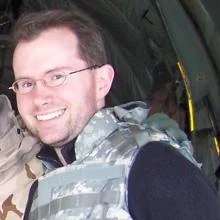With nearly 100,000 followers on Twitter, Federal Communications Commission CIO Dr. David A. Bray was recently named one of the “most social” CIOs in 2014. Since joining the FCC, Bray has been using Twitter to engage, listen, and learn from the public and IT peers, and he believes other executives should too.
The future of IT leadership – in both the public and private sectors – involves more direct, online social interaction with stakeholders and peers, Bray says. In this interview, Bray shares why he sets aside time to engage others on Twitter, what surprises he's encountered along the way, and offers some social media advice for C-level executives.
The Enterprisers Project (TEP): After you arrived at the Federal Communications Commission, you asked to create the @fcc_cio Twitter account. Why was that important to you?

Bray: Yes, one of my first actions as FCC CIO was to ask for an official Twitter account. I had to run this request by folks in legal and public affairs. At first, they asked if I could just start a personal Twitter account and told them I wanted to be @fcc_cio to reinforce that the public engagement I would be doing would actually be on behalf of the Commission’s IT efforts. I also sought to create this account because I knew we were going to have a challenge upgrading the 207 different legacy IT systems that I had inherited in my new role as CIO. As a leader, I wanted to be able to engage, listen, and learn from the public and IT peers as we worked to modernize FCC’s legacy IT systems.
TEP: Are all your posts your own? And can you tell us some of the public engagement you’ve had with the @fcc_cio Twitter account?
Bray: Yes, all the posts are my own. I started the Twitter account because I wanted to give the public a glimpse “behind the IT curtain” regarding the opportunities and challenges of public service. Going in, I knew the modernization of our IT at FCC was going to be challenging. I’ve tried to use the account to engage in open conversations and earnestly discuss about how we can do IT better. I also wanted to recognize the public service team for their successes in modernizing IT along the course of our journey.
Since creating the account, sometimes people online will try to pull me into debates about policy issues and I remind them that I “just do IT” around here. I defer policy questions to Congressionally-appointed commissioners and the capable staff of the FCC’s bureaus.
TEP: How has your Twitter account helped your efforts to modernize legacy IT?
Bray: My year on Twitter as @fcc_cio has affirmed my belief that a diversity of people can bring a lot of great ideas. I’ve interacted with people from all over the United States and internationally as well. At the FCC, we’ve been sharing our efforts as we work to modernize our IT and make the leap from having systems that are 20+ years old to moving all of our headquarters’ IT systems off-site before eventually moving everything in the cloud. In return both members of the public and IT peers share their own thoughts. It’s helpful to be able to say, “Look, here are the challenges we’re confronting with Phase 1, 2, and 3” and hear ideas from folks online.
In particular, it’s nice to know that other people are facing these types of legacy IT challenges – they’re not just limited to our organization. Being a new CIO is like buying a used car, sight unseen, driving off the lot, and only then looking underneath the hood at the “IT engine” you have received. Parachuting in, there were hints that the infrastructure was old and we would have both opportunities and challenges scaling it. Receiving tweets from others in similar IT environments, both in the private and public sector, restores my faith that we can actually make the jump that we need to make.
Another thing I do with my Twitter account is give recognition to different team members who have personal accounts. At the end of a long day where a lot was accomplished, I like to send a tweet giving my thanks and kudos to the team that did it.
Kudos to entire @FCC IT Transformation Team including @JohnSkudlarek @sarahamillican @escheibe @tech_hypomanic @chasaaron @hurshprasad +more
— David A. Bray (@fcc_cio) November 4, 2014
TEP: When do you typically find time to tweet? As a public official have any of the tweets you've received particularly surprised you?
Bray: I don’t tweet much during the middle of the day as usually I’m meeting with people in person. My tweeting usually happens when I’m going home. One of the more interesting exchanges I had on Twitter happened just as I was preparing to leave work one day – I responded to a tweet from the founder of the civic technology blog GovFresh. During a Twitter exchange he referenced something akin to: “The day a CIO is on GitHub is the day the world changes” and I replied (along with a smiley face) that: “The day a CIO is on GitHub is the day they are an overpaid programmer” – because even though I welcome my developers’ use of GitHub, if personally I’m coding in my role as CIO, something probably is wrong. My job as CIO is more about bringing people together around a common purpose, shared vision, and shaping our IT plans.
That same evening, the editor of GovFresh on his own initiative then created a thread on GitHub inviting the public to ask me IT questions. So I opted to stay late and participated in the impromptu GitHub chat session. While it definitely wasn’t “coding” on GitHub, the openness of that exchange was really valuable. The public asked questions about everything from why I’m on Twitter to our IT plans for modernization. It showed that people are interested in the FCC’s IT initiatives, which we were happy to share because we’re a public organization. While I didn’t get home from work until much later that evening, the shared dialogue definitely was worth it. As a public service executive, I believe I have a responsibility to go the extra mile to be open, available, and transparent to the public.
TEP: Do you have advice for other C-level executives regarding social media?
Bray: During that GitHub chat session, I was asked what social media advice I had for other C-level public service executives. My feedback applies to all CIOs, though, regardless of industry. When it comes to social media, pick a few channels to invest in, learn from, and monitor. You don't have to be everywhere, because your hours are limited and you need to focus on your primary job foremost. Be open to inputs and ideas from the public, your peers, and other stakeholders. Social media is much more than "broadcast" – it’s about being open to ideas, learning, and listening.
The Harvard Business Review has a great article entitled “In Praise of Incomplete Leaders” that recognizes the best leaders admit they have blind spots, and those leaders work to find others who can provide skills and viewpoints to overcome this. I find joy and learn a lot when I’m listening to the views of others. For any C-level executive, my question to you is: what could you learn from cultivating a more active and engaged social media community online?
Dr. David A. Bray serves as Chief Information Officer (CIO) for the Federal Communications Commission, overseeing the Commission's efforts to modernize legacy systems and transform technology partnerships in telecommunications, broadband, competition, the spectrum, the media, public safety, and security. He was selected to serve as a member of the Council on Foreign Relations and as a Visiting Associate for the Cybersecurity Working Group on Culture at the University of Oxford in 2014.
Read more: Can CIOs afford to ignore social media?



